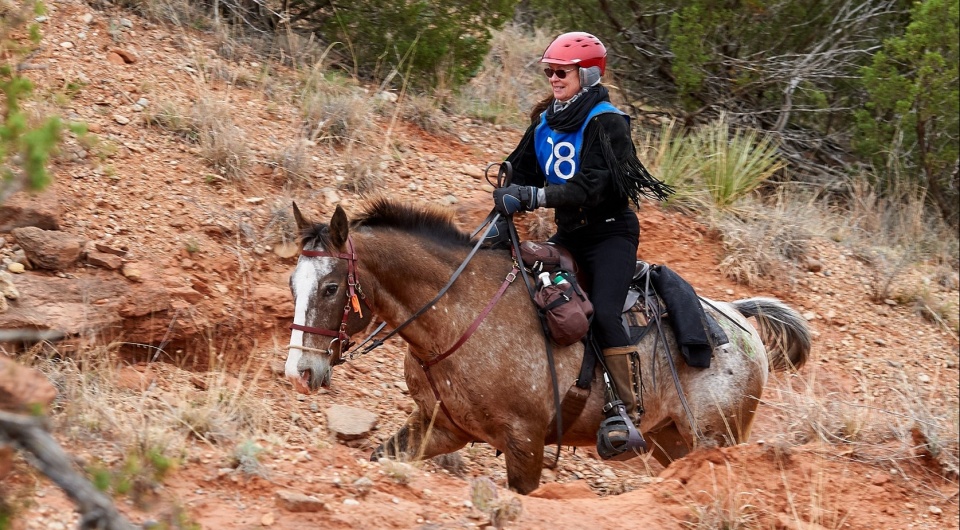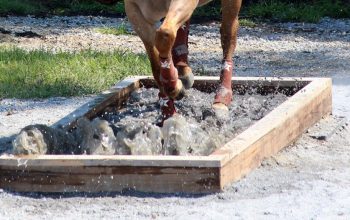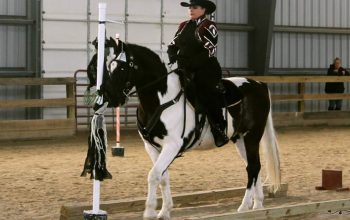By Bev Roberts
Photography by Optical Harmonics: Cheryl Edmondson, Brandy Steele and Jonni Jewell
Really? You bet! Once you arrive at ride camp, there are decisions to make to support a strategy of comfort and low stress during your down time during the long weekend.

Locating and orienting the rig is especially important for the horse when tied to the trailer. Should exposure to morning sun or afternoon sun be the choices, choose shade for the afternoon. After hours on the trail in heat and humidity, the cooler shade will help your horse recover faster, just like you. Those riders who have living quarters trailers with air conditioning can hardly wait to chill out!, In the morning, more than likely you will be timing out a little after dawn. No need for shade then.
If camping is primitive (no electricity), campers, without generators to run their air-conditioning or with no A/C at all, often park so the prevailing breeze blows across their sleeping areas.
If using high ties or supplied pens, always seek a campsite where the horse get first dibs on the shade!
Because most rides are in warm weather, it goes without saying (but, hey, here it is anyway) that the opposite shade strategy is the ticket when attending a cold weather ride. Standing in the sun after a day on the trail will help keep your horse’s muscles warm and reduce potential stiffness and soreness.
There is strategy in selecting a neighbor when camping in close quarters and with horses tied to their trailers. Be it a friend or a stranger (who most likely will become a new friend). Locating and orienting the rig is especially important for the horse when tied to the trailer. Should exposure to morning sun or afternoon sun be the choices, choose shade for the afternoon. After hours on the trail in heat and humidity, the cooler shade will help your horse recover faster, just like you. Those riders who have living quarters trailers with air conditioning can hardly wait to chill out!, In the morning, more than likely you will be timing out a little after dawn. No need for shade then.
If camping is primitive (no electricity), campers, without generators to run their air-conditioning or with no A/C at all, often park so the prevailing breeze blows across their sleeping areas.

If using high ties or supplied pens, always seek a campsite where the horse get first dibs on the shade!
Because most rides are in warm weather, it goes without saying (but, hey, here it is anyway) that the opposite shade strategy is the ticket when attending a cold weather ride. Standing in the sun after a day on the trail will help keep your horse’s muscles warm and reduce potential stiffness and soreness.
There is strategy in selecting a neighbor when camping in close quarters and with horses tied to their trailers. Be it a friend or a stranger (who most likely will become a new friend), consider which side of the trailer to which s/he ties her/his horse. To avoid a potential kicking bout, horses buddying up, or riders disturbing each other‘s horses, savvy riders orient their trailers so that the trailers are between their horses. If a trailer cannot be a barrier, stagger the trailers to leave plenty of clearance for the horses who share the open space between two trailers.
Riding a stallion? Consider camping with geldings as neighbors. No need to lose sleep because of snorting, whinnying, and trailer jiggling as Romeo tries to entice the nearest Juliet who is in heat.
Ride briefing is where riders receive a map for the next day’s trails. The trail master discusses pertinent landmarks, terrain variations, water locations, pulse and respiration (P&R) locations, trail length, trail condition, average pace, completion-time window, checkpoints, signage, and more. The strategy here is to pay attention, make notes and ask questions on anything not understood. The more riders know about the trail, the better they are able to pace themselves. Here is an example.
The point-to-point times on the map are usually mathematical averages based on the overall average pace for the entire day’s ride. A 25-mile ride done in 5 hours has an average pace of 5 mph. It is simply the distance in miles divided by the average pace.
Say the distance from Point B to the first P&R is 5 miles and the average pace is 5 miles per hour, then it will take 1 hour to get to the P&R. If the trail for that segment is mostly a flat dirt trail, making that time is a piece of cake. If the trail is up a steep rock strewn hill on a twisty trail with few clear level places to make time and down the other side in the same kind of conditions, then the best time one can make is likely around 4 mph – a far cry from 5 mph. It will take 15 minutes longer to cover that rough trail than it will an easy one (5 miles / 4 mph = 1.25 or 1:15 (.25 x 60 = 15 minutes).
By understanding the terrain from the trail master’s discussion, after briefing, you can go back to your trailer and plan your ride based on where you can make time and where you cannot. By planning to ride faster in the first two segments – camp to A and then A to B – you can plan on being 15 minutes early to B. You can then plan to slow down for the rough stuff, and still be on schedule at the P&R without risking injuring or overly stressing your horse by trotting through the nasty stuff from B to the P&R.
Remember … strategy is the art of devising a means to an end with a favorable outcome. Less stress, more enjoyment.

Arriving early leaves plenty of time to set up camp comfortably and to shake off the weariness of travel. Activities on Friday usually begin at 2:00 p.m. with the preliminary vet check. Most “normal” people do not have the “ideal” person’s luxuries and must juggle time off from work, money, and home responsibilities to arrive early enough on Friday in order to get their horses checked in by early evening.
NATRC does allow for those who know they will arrive after dark on Friday, or who have encountered delays in route, to check in very early on Saturday morning before the ride start. Give ride management advance enough on Friday in order to get their horses checked in by early evening.
NATRC does allow for those who know they will arrive after dark on Friday, or who have encountered delays in route, to check in very early on Saturday morning before the ride start. Give ride management advance notice.
Another strategy, if ride camp is at a location that takes reservations, reserve early. There will be more choices. Look for sites that are close to a pavilion where management holds meals and the ride briefing, close to the probable vet check location, close to a bathhouse and in the shade. Easy access to all those amenities makes the camping more enjoyable and less stressful after a long day on the trail.
Finally, work out what tack you will use for competing while you are conditioning your horse at home. Then, if you or your horse get rubs, sores or painful areas, you can fix the cause. At the ride, you will not be fretting about tack issues. Less stress, more enjoyment.
_________________________________________________________________
 Since 1961, we’ve helped riders of all ages learn the sport of competitive trail riding. Alongside other equine enthusiasts, you can deepen the relationship with your horse while learning new skills and setting your own competitive goals. There’s no place better to do this than on the open trail.
Since 1961, we’ve helped riders of all ages learn the sport of competitive trail riding. Alongside other equine enthusiasts, you can deepen the relationship with your horse while learning new skills and setting your own competitive goals. There’s no place better to do this than on the open trail.




